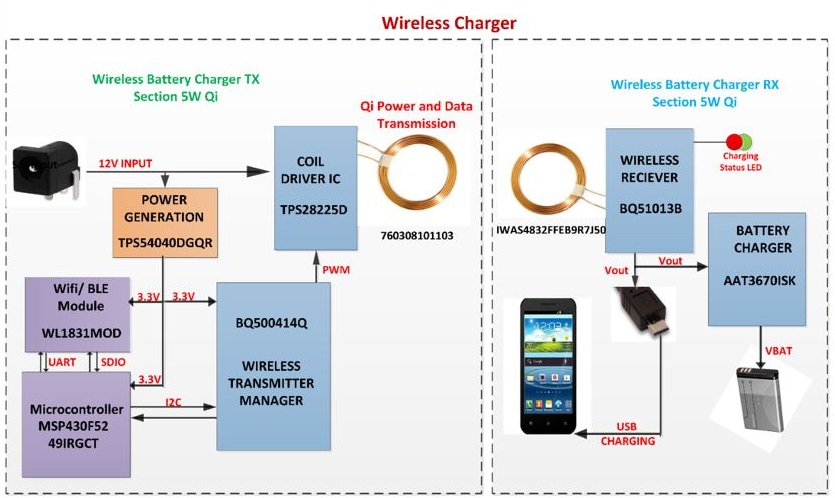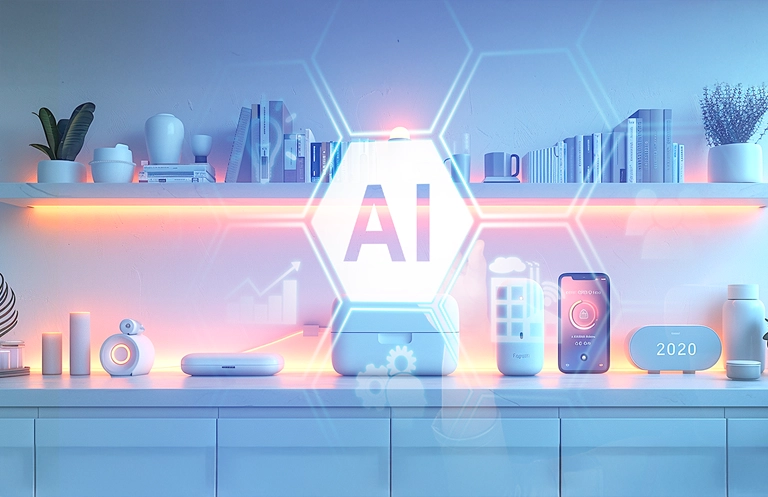All chargers are made of a transmitter and a receiver. The transmitter or induction coil produces an electromagnetic field which transfers the energy across the gap to the corresponding induction coil in the receiving device. The receiver then converts the energy received from the magnetic field to useable electrical current which is then used to charge the battery. Wireless chargers can revolutionize the way consumer devices like cell phones, laptops, iPads are charged. Unlike wired chargers, they can be centrally monitored and controlled via cloud connectivity. Software applications can start and stop charging based on the battery charge status – enabling consumers to remove the fear of discharged device or overcharged device.
Components of a wireless charging system would include
1. Transmitter: The inductive charger acts as a transmitter for transmitting inductive charge. It requires input of 5V DC source with onboard Wi-Fi.
2. Receiver: Another unit acts as a receiver. The receivers are connected to electronic devices for charging. The receiver can be inbuilt in the electronic device or externally integrated as a receiver card which can be installed directly on mobile device charging ports. The receiver should be able to support REST API for IOT/cloud connectivity and standard protocols (MQTT or CoAP) for Security and Authentication. Also Over The Air Firmware upgrade capability is available
3. Cloud Connectivity via Internet: The wireless chargers offer central monitoring and control. Wireless chargers are smart and can be controlled via remote location. An onboard microcontroller is present for Data Logging, Remote Management and Control from a central location and to connect the chargers through the cloud. In addition, the charger can log data related to its usage including its on status, charging period, disconnected status, and the like.
4. Local Connectivity via Wi-Fi: The chargers also gives local feedback and support protocols like BLE/6LoWPAN for local control

Cloud connectivity enables wireless chargers to have the following features & benefits
Functions as an IoT device
The wireless chargers functions as an IoT device and consumers can connect to internet via WiFi.
Local Connectivity Support
Wireless chargers have local connectivity support by integrating with Bluetooth or via direct WiFi connectivity.
Custom communication protocol support
The wireless chargers support custom communication protocol, which is developed at hardware firmware level to communicate with the devices. These protocols are required for remote device management/data logging and local connectivity support.
OTA (Over The Air) Upgrades
The wireless chargers support OTA firmware upgrades enabling consumers to have the latest firmware & patches for the charger system
On/Off Switch
Wireless chargers also have conventional manual on/off switch for control by users.
Stop Charging – After full charge
Wireless charging stops once the full charge for device is achieved. This is also showcased by a visual notification, and LED colour change.
Support for discovery protocol
The chargers support the discovery protocol like SSDP. One can find available chargers on available network through the discovery protocols.
Standard Protocol
It is required that the wireless charges should support standard IoT protocol like MQTT/ CoAP
Security
The chargers supports security and authentication and adheres to protocols while provisioning custom security features. Security protocols are decided based on identified protocols for communication like MQTT/CoAP/Custom REST based.
Featuring comprehensive advanced components & cloud connectivity, wireless chargers have complete potential to revolutionize charging. However, wireless chargers adoption is currently limited due to two factors: Cost & Range. The cost of wireless chargers is 3-5 times more than wired chargers. And when it comes to range, one of the problems with inductive charging is that the energy transfer is less efficient since the distance between the charger and the device results in potential energy loss. Also, the electronic devices needs to be specifically aligned with the charger and cannot be moved while charging.
In recent times, companies like Samsung, Microsoft, Nokia, Motorola and LG have formed the Wireless Power Consortium (WPC). The WPC has specified Qi standard for inductive charging so that any Qi certified electronic device can be charged with any Qi certified charger. Going forward, we can hope that WPC will overcome limitations of wireless charging & lead to mass scale adoption of wireless chargers.












